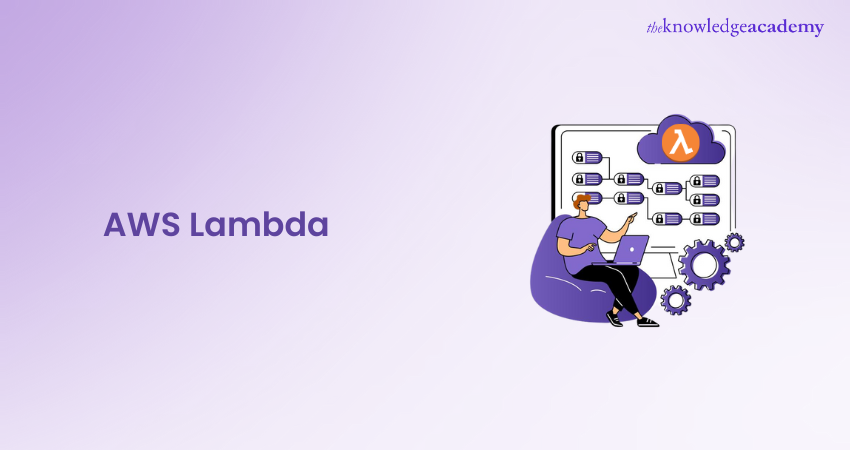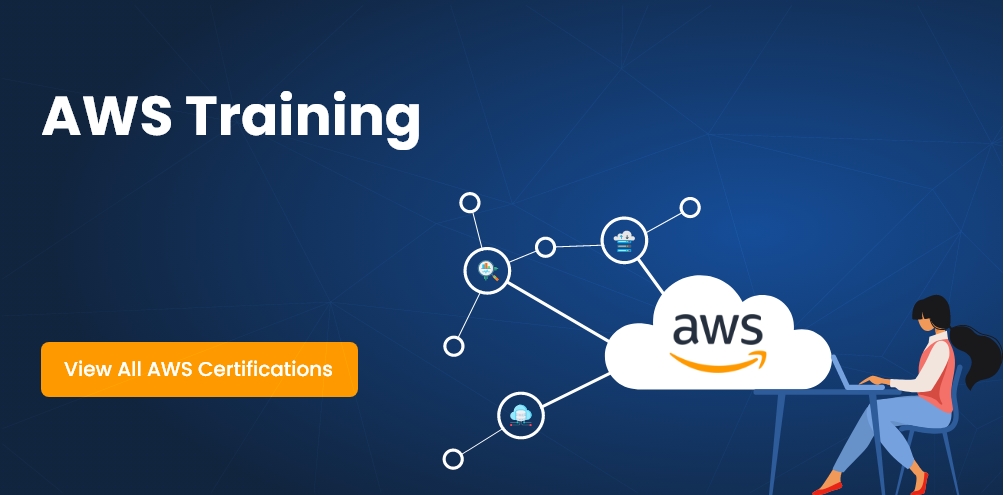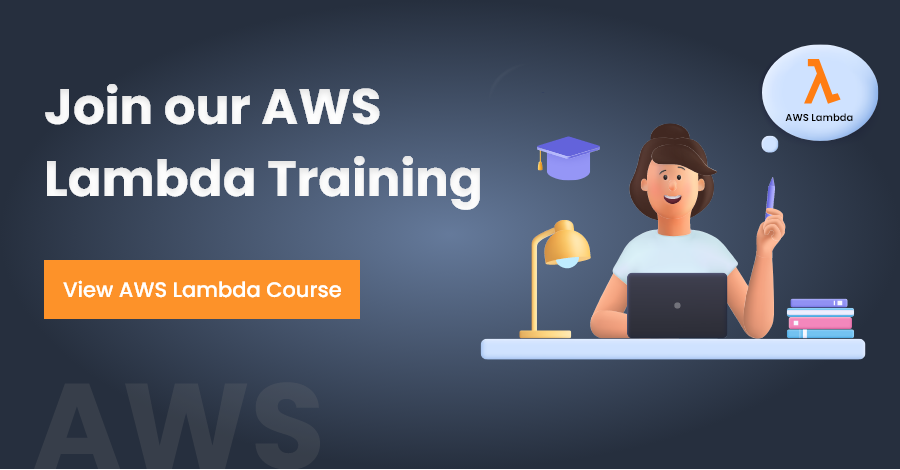We may not have the course you’re looking for. If you enquire or give us a call on 01344203999 and speak to our training experts, we may still be able to help with your training requirements.
Training Outcomes Within Your Budget!
We ensure quality, budget-alignment, and timely delivery by our expert instructors.

AWS Lambda is a serverless cloud compute service provided by Amazon. It plays a significant role in all operational and administrative activities. It is a serverless computer where you can build your applications.
Top companies like Zendesk, Capital One, Netflix, Autodesk, Data Inc, and more than 8,201 companies use this service offered by Amazon. Nowadays, most companies have adopted Lambda. It also provides many other similar services such as EC2, Amazon S3, Amazon API, DynamoDB, Amazon SNS, Amazon Kinesis, CloudFront, CloudTrail, and Mobile App.
This blog is designed as an essential guide for beginners and will provide all the information you need to know about AWS Lambda.
Table of Contents
1) What is AWS Lambda?
2) Some Basic AWS Lambda Concepts before we move on
3) Ever Wondered how does AWS Lambda Work?
4) What are Events that Trigger Lambda Function?
5) How to Create an AWS Lambda Function?
6) Technical details about AWS Lambda
7) How much does AWS Lambda Cost?
8) Applications of AWS Lambda
9) Top 3 use Cases of AWS Lambda
10) Advantages of AWS Lambda
11) Disadvantages of AWS Lambda
12) Conclusion
What is AWS Lambda?
AWS Lambda is a computing service launched by AWS (Amazon Web Services). It is a serverless computing platform used for writing and executing your code without a server. Lambda helps you handle the entire infrastructure and administration of the application.
It has its own run-time platform called Lambda Function. It executes the code based on the response of events in Lambda service, that is adding and deleting files in the backend. All you need to do is work on your code, and Lambda will take care of the rest.
Learn more about AWS Lambda. Join our AWS Lambda Training today!
Some Basic AWS Lambda Concepts before we move on
There are some basic concepts of AWS Lambda that you need to know before starting with it:
1) Function: You can invoke a function to run your code in AWS Lambda. It has a code for processing events that you pass through the function.
2) Layer: In AWS Lambda, a Layer is a .zip archive consisting of code and other files such as run-time environment, data, configuration files, and libraries. .zip archives make the deployment process faster by reducing the file size. Layers help share your code. The contents get extracted to the “/opt” directory in the execution environment when layers are added to a function. Any layers you create are secured and private in your AWS account. Sharing the layer is the only way to make it public.
3) Trigger: A trigger is used to call a Lambda function. AWS services are included in triggers and can be modified to call event source mappings or a function. Event source mappings help read items from a queue and call a function.
4) Execution Environment: It gives a private and protected run-time environment for code execution. It also handles all the resources and processes needed to run the code.
5) Run-time: Run-time handles tasks like calling an event, context information, and responses with Lambda and function. When you package your code as a .zip archive file, you need to set up the function to use a run-time environment that corresponds to your programming language.
6) Events: An Event is a Json-formatted document consisting of data for the processing of Lambda function. It transforms the events into objects and moves them to the function code.
7) Instruction set architecture: It determines the computer processor types. Lambda will give you a choice to set the architecture:
|
“arm64--64-bit ARM architecture, for AWS Graviton2 processor” |
|
“x86_64 – 64-bit x86 architecture, for x86-based processors” |
8) Deployment package: Using the deployment package, you can deploy your Lambda function. Lambda supports two sorts of deployment packages:
A) A .zip archive that holds your function code and its dependencies.
B) The OCI (Open Container Initiative) specification compatible container image.
9) Extension: It allows you to augment your functions. Using extensions, you can combine your functions with observability, monitoring, governance, and security tools.

Ever Wondered how does AWS Lambda Work?
Let’s learn more about the Lambda function. Working on AWS Lambda is very efficient and simple. Let’s discuss its working in more detail:
Lambda Function:
You can write a code in Lambda’s code editor or upload your own code and specify the conditions that trigger the code. Lambda’s runtime environment runs your code. This code is called Lambda function. Developers need not worry about handling servers and do not need to pay when their codes are not executed in Lambda.
Event Sources:
The actual process starts when an event is triggered. Lambda chooses the perfect resources in infrastructure environment and executes the code. The control plane entity from Lambda’s run-time environment contains APIs that assist AWS resources for the code execution illustrating the intricate interaction within the AWS Architecture and its underlying components. Data pane from Lambda’s run-time environment contains APIs that assist in running the function. In the code execution process, any one of the entities get allocated to run the code.
Workflow of AWS Lambda
1) Upload the code in AWS Lambda’s code editor
2) Configure your code to trigger from other AWS services
3) AWS Lambda executes your code when gets triggered
4) Pay only when your code is executed
What are Events that Trigger Lambda Function?
When you are executing a code in Lambda, events play a key role in triggering the Lambda function to run your code. Anything from a resource within your AWS account that can act as events.
Events are divided into two sets of event sources.
A) Synchronous
B) Asynchronous
Let’s see the events that triggers Lambda function.
1) Inserting, updating, and deleting the data in Dynamo DB table
2) To search the log history in CloudTrail
3) Entry into an S3 object
4) AWS Lambda may get triggered by Dynamo DB when data is deleted, added, updated
5) To include push notifications in SNS
6) Helps to schedule the event to execute the task at usual time pattern
7) Modifications to objects in S3 buckets
8) Notifications sent from Amazon SNS
9) AWS Lambda can be used to process the CloudTrail logs
10) API Gateway allows you to trigger AWS Lambda on GET/POST methods
Check here to configure the events for your Lambda function.
How to Create an AWS Lambda Function?
Before creating a function, you need to create an account and set up the configuration of AWS Lambda. Let’s see the initial process of creating a function.
Open the AWS website in the browser and create a new account. Then create an IAM (Access Identity and Access Management) account and get an admin user ID- it does not require the root credentials. For console access, create a password. Also, create access keys for command line tools.
Lambda supports two sets of deployment packages to deploy the function.
A) .zip file achieve consists of function code and its resources
B) Container image compatible with the Open Container Initiative (OCI) specification
Build an AWS Lambda Function on your Console
In your console, create a Lambda function. You need a .zip archive deployment package to upload the Lambda function code if it is a compiled language. For non-compiled languages, the Lambda console gives a code editor which helps in editing and testing your code.
Using Lambda console, create a Node.js Lambda function. By default, it creates a code for the function.
Now, you can create an AWS Lambda function within a few minutes by following the steps below:
Step:1 Go to the Functions page in the Lambda console.
Step: 2 Select Create function.
Step: 3 Find the Basic Information and below that, enter “my-function” to create a Function name.
Step: 4 Now, make sure that Node.Js 14x is chosen for Runtime.
Step: 5 Finally, click Create Function.
Call the Lambda Function
1) To call the Lambda function, select your function and select the Test section.
2) Select New event from the Test event section and leave the hello-world option selected in Template. Mention a Name for the test and enter this template:
{
"key1": "value1",
"key2": "value2",
"key3": "value3"
}
3) Now, click Save changes and select Test. After this, Lambda will execute your function and the function handler will accept and process the sample event.
View the Result of the Function
1) After the completion of the process, you can find the result as succeeded under the Execution result
2) To view Log groups, click the logs link section
3) To view the Log output, click the Summary section
4) Log output will show you the Lambda logs for each call. These logs are written in CloudWatch. You can select Click here to add the logs to CloudWatch log group. If you want to open the logs in CloudWatch, you can do so by clicking on Log groups
After you’ve seen the results, you can run the function by clicking on Test. This will generate metrics that can be viewed by clicking the Monitor button.
Deleting Process
1) To delete a Lambda function, go to Actions -> Delete. Then, click the Delete button in the Delete function dialog box
2) To delete a log group, open the Log groups page in the CloudWatch console and select your function’s log group “(/AWS/lambda/my-function)”. Now, go to Actions -> Delete log groups. Then, click the Delete button in the Delete log groups dialog box
3) To delete the execution role, open the Roles page of the AWS IAM (Identity and Access Management) console. Now, choose the function’s role “(my-function-role-31exxmpl)” in the dialogue box and select Delete role. Then, click the Yes, Delete button in the Delete role dialog box
Technical details about AWS Lambda
There are some technical specifications of AWS Lambda that you need to be familiar with:
1) The Package size of lambda is 50MB (compressed file) and250 MB (uncompressed file)
2) Memory allocation is 128MB to 3008MB
3) Languages supporting are Java, Node.js, Python, Ruby, C#, PowerShell, and GO
4) Run-time duration is within 15 minutes
5) Functions work in a container called Sandbox
6) Disk space allocation is 512 MB
How much does AWS Lambda Cost?
If you’re planning to buy AWS Lambda, you should know how the pricing works.
The cost of AWS Lambda service is calculated based on two main parameters-
A) Request
B) Time
Costs based on Requests and Time
What is a Request in Lambda?
A Request is a command from a user to Lambda (serverless computing). The request moves to the Virtual Machine to process the function and returns the response to user.
How does time play a Role in Pricing?
Time calculation is based on when your code starts executing, until the process ends, and how much memory did it consume. AWS charges a certain amount for this process.
AWS follows the “pay-as-you-use" method. After creating a new account, they offer a free tier slot to use Lambda service.
In free tier, you get 1 million free requests and 3.2million seconds of compute time. After the free tier, it costs
£1.7e-7/request and £0.000014 for every GB per second consumed.
Applications of AWS Lambda
The AWS Lambda application is simply the blend of resources, events, and functions that come together to perform a task. Using CloudFormation you can gather the application’s elements as individual packages. Lambda applications facilitate making your app portable and merging with developer tools like CodePipeline, CodeBuild, and SAM CLI (Serverless Application Model Command Line Interface).
Serverless Application Repository: It provides a set of Lambda applications. With a few clicks, you can deploy Lambda applications in your account. For your projects, you can use the sample applications from the repository.
AWS CloudFormation: It helps you build a template that enables you to manage your application as a stack and define your application's resources. With this, you can securely modify and add your resources to your application stack. In case of any failure in the update, it automatically goes back to the older configuration. From the same template, you can develop various environments for the applications using AWS CloudFormation parameters.
AWS CLI and SAM CLI: These are command line tools that can be used to manage Lambda’s application stack. SAM CLI helps in uploading deployment packages and updating templates by supporting high-level commands. It gives extra operations such as template validation, local testing, and integration to CI/CD pipeline systems.
Top 3 use Cases of AWS Lambda
AWS Lambda can be used in many ways to reduce your workload. Let’s see some of the best use cases of Lambda.
1) File Processing
2) Websites
3) Mobile Applications
1) File Processing: If you have a Video sharing app, users can upload videos in the App, which are stored in the AWS S3 bucket. After that, a thumbnail version of the video will be displayed on the user profile. For this process, you can create a Lambda function and make it automated to create a thumbnail. AWS S3 is an AWS event source, that helps to publish an object-oriented event and call your Lambda function.
2) Websites: If you made a website and you would like to host the backend logic on Lambda, you can call the Lambda function through HTTP by using the Amazon API Gateway as an HTTP endpoint. This makes it easier for the web client to call the API and the request is redirected to Lambda.
3) Mobile Applications: If you have a mobile app, which generates events, you can build a Lambda function to process an event that is published by your application.
Advantages of AWS Lambda
Are you curious why Lambda is so popular? Here are some advantages of Lambda.
1) It executes code within milliseconds
2) Monitoring code is easy through CloudWatch
3) A virtual machine is not required
4) It executes code based on requirements
5) It supports more than thousands of requests per day
6) AWS does not charge you any amount when your code fails to execute
7) You’re only charged when your function is in use
8) It is cost-effective
9) The billing time for Lambda is from 100ms to 1ms
10) Advanced infrastructure and facilities
11) Many event triggering options are available such as Dynamo DB, AWS S3, API Gateway, Code Commit, etc.
12) Highly secured and scalable
13) It handles the administration of computer resources, servers, and operating system maintenance
Disadvantages of using AWS Lambda
Every technology comes with some drawbacks, and AWS Lambda is no exception. Some disadvantages of AWS Lambda are listed below:
1) Request memory of any event should not increase more than 128KB
2) Memory is limited between 128 - 1536MB
3) You cannot install external software for your code because AWS Lambda completely depends on AWS for its infrastructure
4) It can only execute up to 100 codes at the same time
5) It is only suitable for big projects
6) CloudWatch is the only available space to write logs for error handling, troubleshooting, and monitoring in Lambda
Conclusion
Now you know quite a bit about what AWS Lambda is, how it works, its concepts, applications, use cases, and more. Keep in mind that hands-on experience is much more effective than just theoretical learning. Keep working on Lambda functions to hone your skills.







 Top Rated Course
Top Rated Course




 If you wish to make any changes to your course, please
If you wish to make any changes to your course, please


